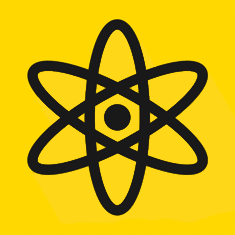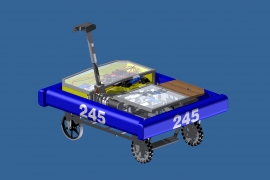2010: Breakaway
Breakaway was played by two competing alliances on a 27 by 54-foot field. Each alliance consisted of three robots each. They competed to score soccer balls in the opposing team’s goal during a two minute and 15 second match. The more goals they scored, the more points their alliance received.
The Field
Breakaway was played on a 27 by 54-foot carpeted area, surrounded by a guardrail system and alliance walls. Tape covered the field and distinguished different zones. Goals were located on the end corners of the field directly in front of the alliance stations. There were three parts to the field and two towers separate each zone. On either side of the tower were bumps where teams are able to cross onto each zone. A hole was located below the towers through which robots could also freely navigate.
Game Pieces
The game pieces represented the exact dimensions of a size five soccer ball. Each ball was worth one point. A total of 12 balls were placed onto the field, spaced out evenly across each of the three zones.
Autonomous Period
Teams were able to pre-program their robot to perform certain functions and maneuvers without control of the drivers. Students could program the robot to shoot balls or to simply get them in a position on the field before the teleoperated period. All maneuvers had to be within the game rules and parameters. The autonomous period lasted a total of 15 seconds.
Teleoperated Period
The teleoperated period followed the autonomous period. Teams were able to assume control of their robots. An alliance’s main objective was to score balls into the opposition’s goals. Each soccer ball was worth one point. Robots could hang and suspend one of their robots on top of their own tower, which was worth two points. If a robot was able to hang or suspend on an already suspended robot, their alliance gained another three points. The goals that were scored will be returned to the field through the ball return rack by a human player. The ball return rack caused the soccer ball to roll toward and drop into the center playing field
Scoring
A scored ball earned a team one point. Towards the end of the match, bonus points were awarded for robots that were able to hang on top of a tower. A suspended bot won two points and if a robot was able to hang from or suspend on top of an already suspended robot, the alliance gained another three points. The total score from the autonomous and teleoperated period were calculated and added together at the very end.
Our Solution: Veronika
-
Drivetrain
- Four wheels driven by two Andy Mark Tough Boxes with two CIMs.
-
Arm
- Gas spring expansion
- Grabs side pole
- Pulled by CIM driven belt winch
-
Sensors
- Limit switches
- Potentiometers
-
Features
- Easy control system drop down
- Mostly Modular
-
Specifications
- Weight: 105 pounds
- Dimensions: 27.5 x 37.5 x 17.75




